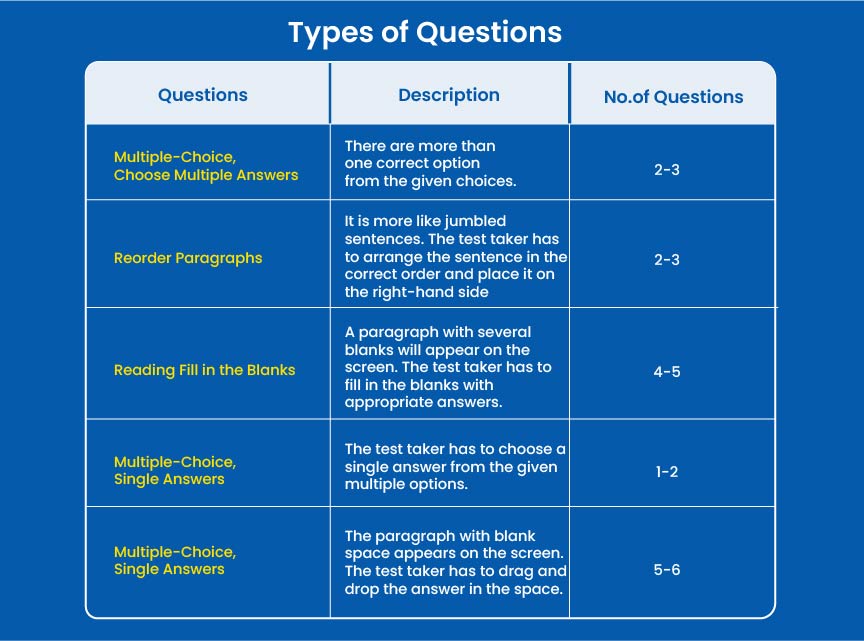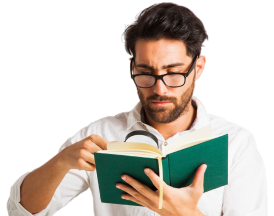PTE reading is one of the most crucial elements of the language proficiency exams. It assesses your ability to comprehend the language. Thus, understanding the PTE reading rules is crucial. Hence, contributing a major part to the total scores. Each question type has specific instruction that you must read before attempting the questions.

Table of Contents
Rule 1: Have/has/had + past participle tense (V3)
Rule 2: Am/is/are/was/were + past participle tense (V3)
Rule 3: Be/being/been + past participle tense (V3)
Rule 4: Preposition 'to' + first form of the verb (V1)
Rule 5: Preposition with, of, for, about + verb+ing
Rule 6: Articles a/an/the + noun
Rule 7: Article a/an/the + adjective + noun
Rule 8: Modal verb + first form of the verb
Rule 9: Many + Plural nouns
Rule 10: It/which/that + Singular form of the verb -s/-es
Rule 11: Conjunction Rule
The second part of the PTE exam is the reading section. It lasts for 29-30 minutes. Moreover, it contains five different questions types. These are
You will know about them in the upcoming section. Moreover, in this blog, you will learn about reading rules for PTE along with the significance of knowing them.
The PTE reading section is among the crucial segments contributing to overall scores. You should know the PTE grammar rules and types of questions to ace the exam. Also, you can refer the pictorial representation below to know the types of questions and their description.
This table mentioned about the various types of questions that a test taker comes across in the reading section. In the upcoming section, you will learn how important PTE reading rules are.
Also Read: PTE Read Aloud
The grammar rules for PTE reading section are crucial to understand. In this section, you will know the benefits of knowing the PTE reading rules. A few of them are mentioned below.
After have/has/had, choose the past participle of a verb with the form -ed or the third form.
For example:
After am/is/are/was/were, choose the past participle of a verb with the form -ed or the third form.
For example:
After be/been/being, choose the past participle of a verb with the form -ed or the third form.
For example:
After the preposition “to”, choose a verb in the present or first form of the verb. Remember to not use ‘-ing’ form of verb with the preposition ‘to’.
For example:
After the prepositions ‘with’, ‘of’, ‘for’, and ‘about’, use verbs ending in ‘-ing’.
For example:
There are two types of articles:
‘A’ or ‘an’ usually comes before ‘the’ before the same noun in a paragraph.
Remember that nouns always come after articles. So, if the blank comes after a/an/the, you will quickly identify the noun from the filling options.
Here are 3 Article Rules:
While rule 6 states that a/an/the goes with nouns, they may go with noun phrases (adjective + noun).
If there is a blank between an article and a noun, we will specify an adjective to fill in.
For example:
can/ could/shall/should/may/might/will/ would/must/have to + first verb form. A modal verb (or modal auxiliary verb) expresses the certainty and uncertainty of action.
For example:
After ‘many’, look for a plural noun to fill in the blank. The plural form of a noun will always have “-s, -ies or -es”.
For example:
After it/ which/ that, you must fill in the blank with the singular form of the verb with -s or -es.
For example:
The verb form must be consistent before and after a conjunction.
For example:
These were a few PTE reading rules that you follow in order to ace the exam in the first attempt. If you are unsure about these, then you can contact the experts. However, the next section contains the PTE reading tips and tricks in order to ace the language proficiency test in the first attempt.
Also Read: Retell lecture in PTE
The experts always gives PTE reading tips so that the students can ace the reading section of the PTE exam in the first attempt. However, each question type requires special strategy to ace. Refer to the image below to reading rules for PTE questions and know the way to excel it.
In the above image, you got to know the way to ace each question type. Now, let’s know the PTE reading tips and tricks to clear the reading section.
Following these tips will help you to ace the reading section in the first attempt.
Enroll for the best PTE Coaching classes online and get desire score in your first Attempt
Book Free PTE MasterclassIn conclusion, you got to know about the reading rules for PTE exam. Also, you are now aware of the grammar rules to ace the reading section of this language proficiency exam. If you want to improve your skills, then you can sign up for PTE reading practice test. Platforms like Gradding allow you to take mock test even without classes. So, enroll today and clear the language exam tomorrow.
Also Read:
The reading section lasts for around 30 minutes. Also, it contains five various tasks. These includes
Yes, you can get full marks in the PTE reading section with the right preparation. Also, knowing the PTE reading rules is important to get full marks in this section.
PTE reading section is considered the toughest of all in the PTE exam. But consistent practice will help the test taker to ace it with desires scores.
There are many ways to practice the PTE reading section. You can enrol in PTE classes or just sign up for reading mock test. These two things will help you a lot in practicing for this section.
There are two types of scoring in the PTE reading section. One is correct/incorrect and other is partial credit. Also, the marks in the reading section of the PTE exam gets deducted. So, the test taker must be careful while attempting this part of the language exam.

We are available in :
BangaloreAhmedabadJaipurHyderabadKeralaPuneChandigarhMumbaiGurgaonChennaiKolkataTrivandrumNoidaKochiCalicutKottayamKollamThrissurIndoreUdaipurdisclaimer:logos and other registered trademarks of universities used on this platform are held by their respective owners. Gradding does not claim ownership or association on them, and their use is purely for informational and illustrative purposes.



